Snubber Bridle Materials
Sound design, choice materials, and solid construction make for a quality product. Snubber design is simple, but there are a couple of design considerations with bridles; we discuss them on the Snubber Bridle Design page. Materials and construction are covered here.
Lines
When considering the three critical requirements for a snubber or bridle - elasticity, strength, and ability to withstand the marine environment - nylon rope fits the bill. Saltwater, UV degradation and chafe are a given but add heat, possible exposure to chemicals and an almost constant state of being saturated would degrade some ropes in a single boating season. At 49° North Marine, we use 3-strand nylon for snubbers and bridles almost exclusively due to it's near-ideal properties, low cost and splicing ease. Given the relatively short lifespan of a snubber or bridle, we don't see the need to purchase expensive braided or plaited rope. We've dedicated a full page to nylon rope to assist in the selection process - see it here. For estimating the diameter and length, try our calculator here.
Shackles
Manufacturing Process
Shackles come in various materials, including iron, steel and stainless steel, and are manufactured using casting or forging processes. In casting, the metal is melted and poured into a mold. The final product is not as strong as its forged counterpart as casting disrupts the metal's tight grain structure and can create tiny air pockets that affect strength. Cast products are usually not load-rated. Forging uses force - with or without heat - to form the steel into the desired shape. Since the metal is not molten, it retains a tight grain and maintains much of its original strength. As a result, forged shackles are approximately 25% - 35% stronger and are usually load-rated.
Types
Shackles come in many shapes and sizes, but bow shackles are designed for omnidirectional loads and are the standard for
snubbers and bridles. When possible, use name brand, forged and load rated shackles. For additional strength, consider anchor shackles
as they have an oversized pin.
[Images: left - bow shackle, right - anchor shackle]
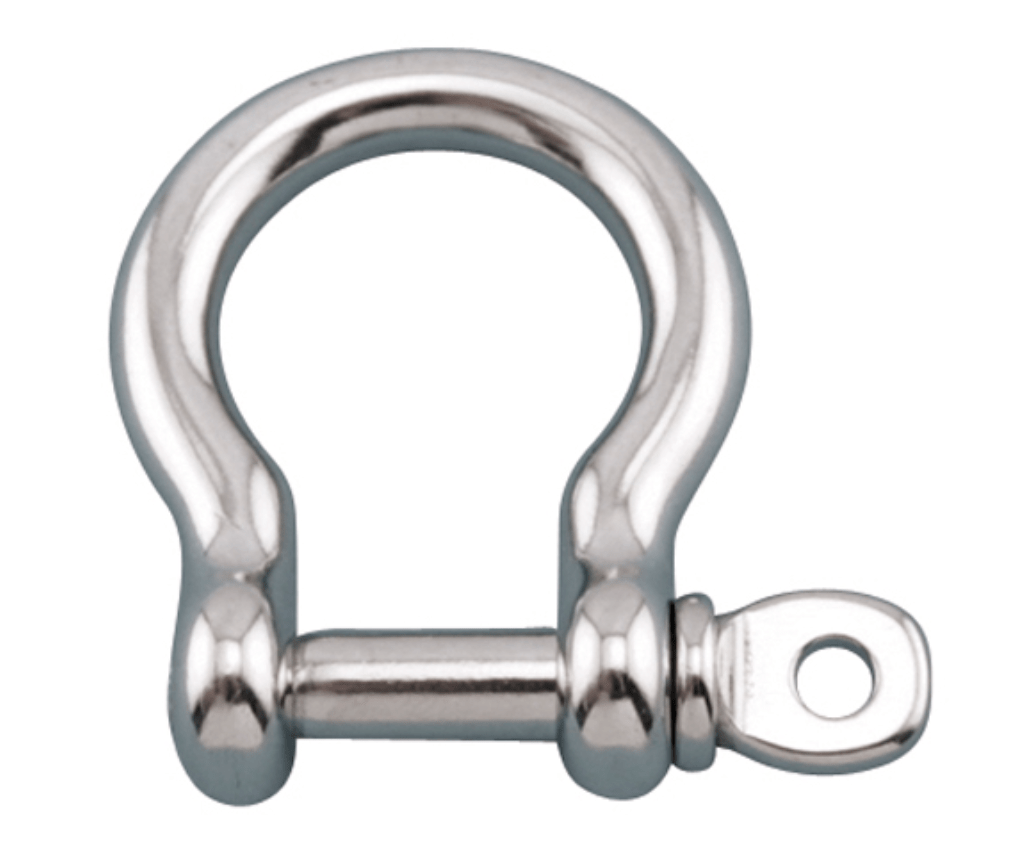
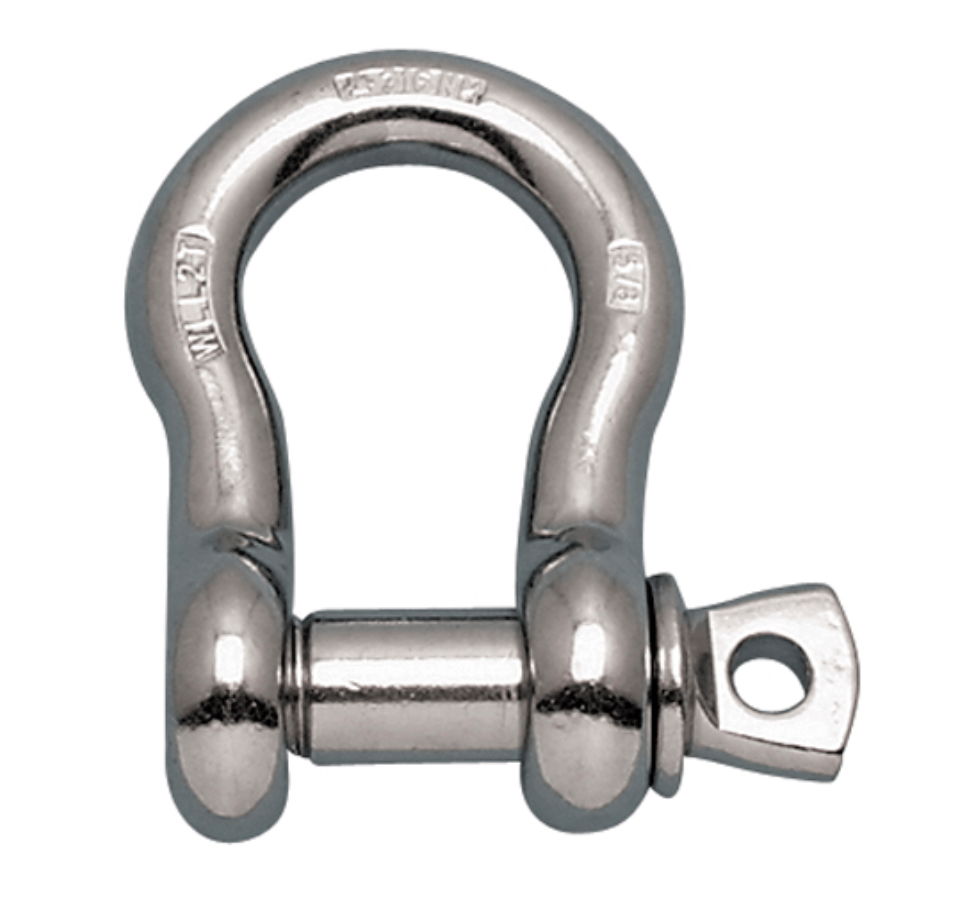
Thimbles
Probably the most critical consideration when selecting thimbles is their ability to maintain shape when loaded. The thimble
maintains the radius (4:1) of the eye thus reducing the impact of the rope's bend on its strength. Thimbles typically come in light or
heavy-duty. Consider using the heavy-duty option for boats which are heavy for their length, or have extraordinary windage. For larger heavy duty thimbles,
be prepared to pay many times the cost of the lighter option. In addition to weight, thimbles also fall into one of two design patterns: open and closed.
Open is by far the most common and is ideal for most applications. Closed (image below right) thimbles, however, should be considered for storm bridles. With
the tension loads incurred during a storm, the line around the hard eye can stretch enough to allow the thimble to turn, or even fall out. If an open thimble
turns in the eye, it can cut the line if it's not well seized. Closed eye thimbles have smooth rounded aprons that prevent this type of cutting action.
[Images: L-R - thimble, heavy duty thimble, extra heavy duty thimble (great for storm bridles)]
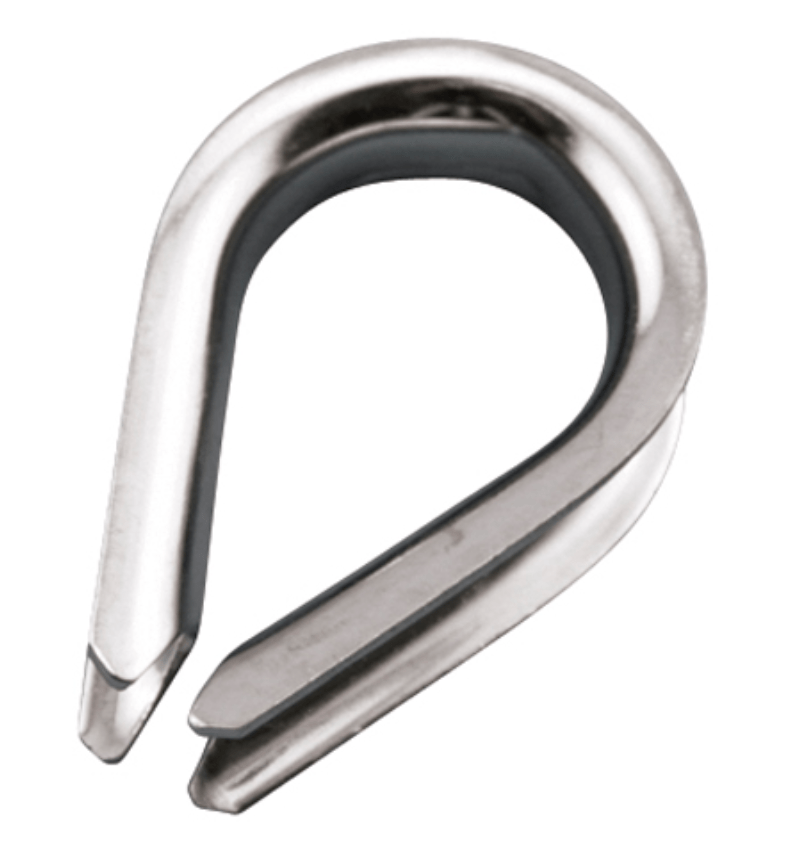
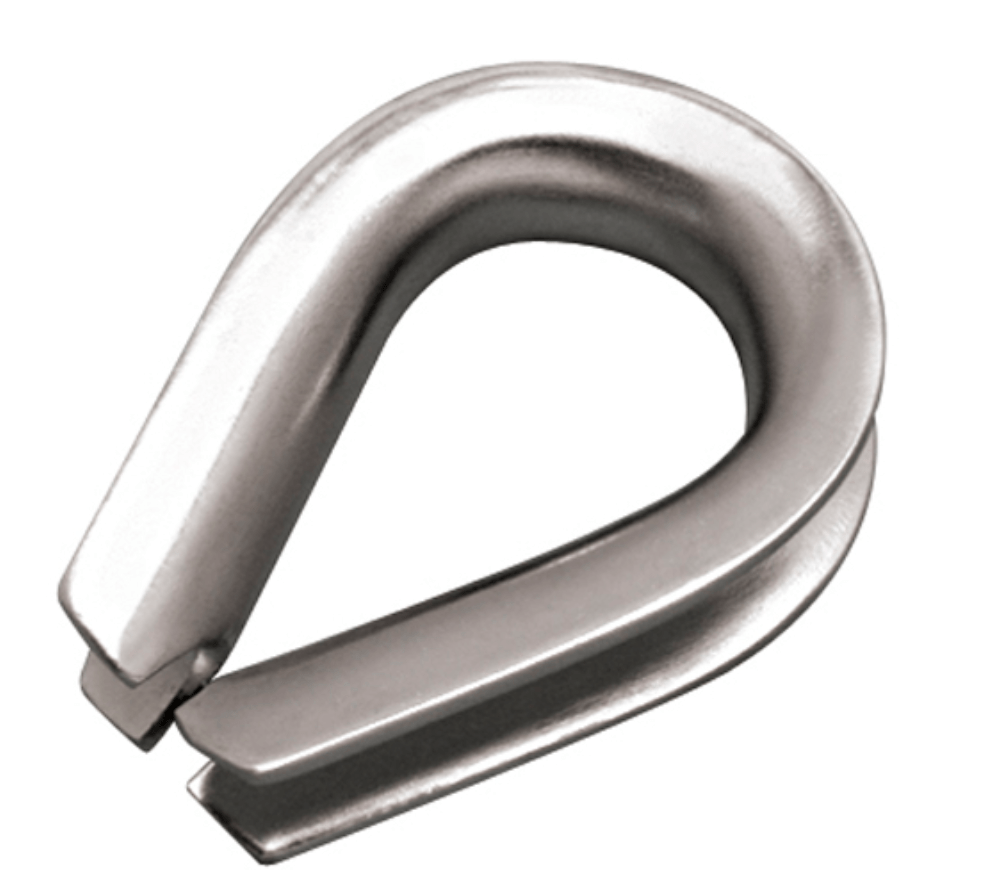
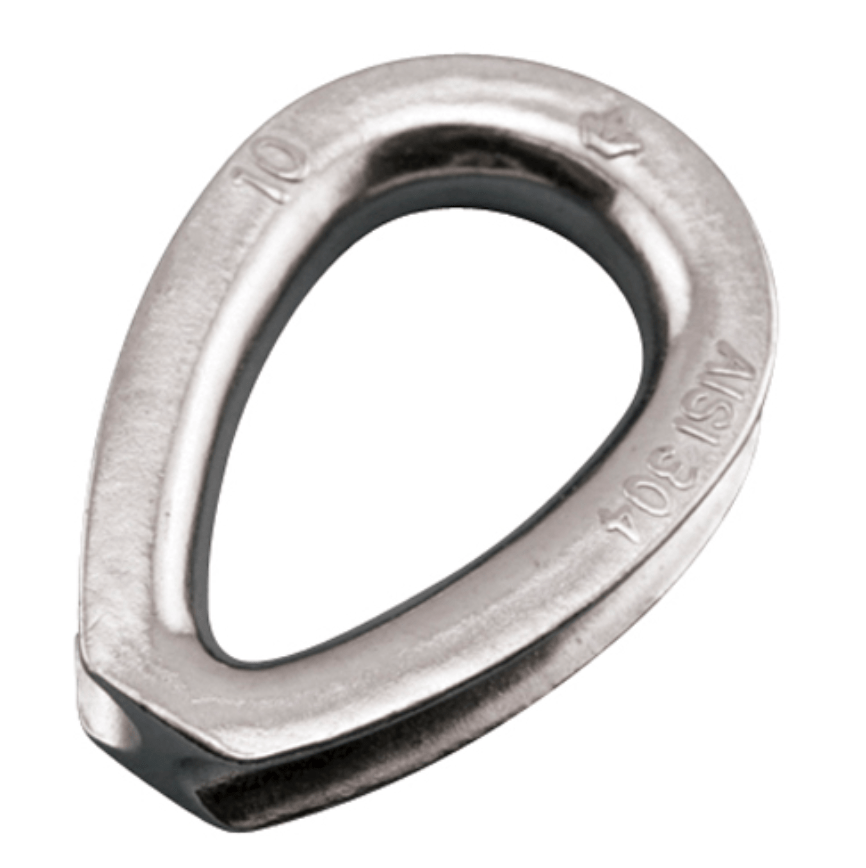
Snubber Bridle Hooks
Given the breadth of options and opinions, we've dedicated a full page to chain hooks - Snubber Bridle Hooks.
Anti-Chafing
At 49° North Marine, we use several different products but prefer ChafePro®. We use tubular climbing webbing and products made specifically for anti-chafe - ChafeGuard and ChafePro® (ChafeGuard was recently rebranded as ChafeMaster, I think). We've found that where a single snubber line runs over the anchor roller assembly, we leave the chafe sleeve loose to allow the line to run freely within it. The friction occurs between the anti-chafe and the line. Why? Snubber lines running across bowsprits, through roller assemblies and on top of chains tend to get snagged. Fixing the anti-chafe to the snubber line where it runs across these snag points quickly destroys the anti-chafe and ultimately snags the rope.
Where bridle lines run through chocks or leads, we recommend having tensioners that hold the anti-chafe tightly on the rope (e.g. the rope can't slide back and forth within the anti-chafing) so any rubbing happens directly between the anti-chafe sleeve and the hardware.
There are better anti-chafe products than the aforementioned, but they are expensive. Tubular anti-chafe will satisfy most requirements but crews know their boats and these less expensive sleeves might not be ideal for some. On my boat, the starboard stern chock can chew through anti-chafe sleeves like an all-you-can-eat buffet. There are no sharp edges, extreme angles or obvious odd motion that might cause high loads and chafing. The anti-chafe sleeves used elsewhere show no visible signs of wear after 3 years of use. Go figure.
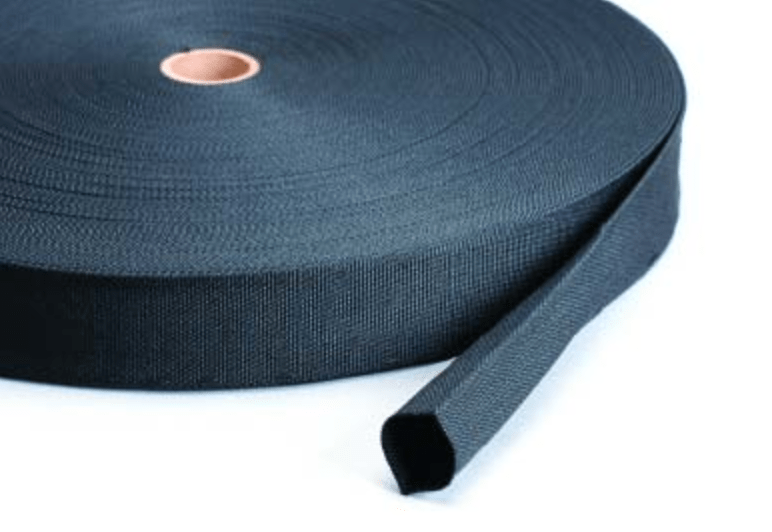
Snubber Bridle Construction
Finish - Hook End
There are several ways to attach a hook to rope to create a snubber or bridle, but given the snubber or bridle's load, some methods are better than others.
Hard Eye
Hard eyes, thimbles spliced into an eye, are the most commonly used treatment for the hook end of a snubber because this method has the least impact on the rope's strength. Splicing retains ~90% and the thimble - assuming the thimble retains its shape and the splice is done per manufacturer's specifications - retains around 75%.
When splicing, 5 - 7 tucks is best for nylon line. 5 tucks for larger medium or hard lay line is fine, but consider a couple more on smaller lines (1/2" or smaller), or for any size soft lay (uncommon) line. Prior to trimming the ends remaining after the final tuck (the tails left at the rope end of the splice), load the splice minimally with your bodyweight or use winch to lightly load it. This will stretch and "settle" the splice. Failure to do this and cutting the tails too short will result in the tails getting pulled back through the tucks. Once trimmed, tape or melt the ends to prevent unravelling. Caution: melting nylon produces hydrogen cyanide which is highly toxic.
Shackle and Seizing
Use a bow or anchor shackle to attach the hard eye to the hook. Once the hook is attached, tighten the shackle pin with an adjustable wrench. The torque generated by a shackle tool is insufficient for this application as are open end wrenches for the respective pin size. Consider seizing the pin with blue Loctite® or annealed SS wire. We use the following for wire seizing:
| Shackle Size | 5/16" | 3/8" | 1/2" | 5/8" | 3/4" |
|---|---|---|---|---|---|
| Wire Size | .032" | .032" | .041" | .041" | .041" |
| Wire Length | 3" | 5" | 7" | 9" | 12" |
These lengths allow for doubling the wire and twisting it closed.
Splicing Directly to Hook
When splicing directly to a hook, using a thimble is recommended if the hook's eye will allow it. Splicing directly to the hook creates a small radius bend in the rope it and it will greatly reduce its strength. The former option is ideal but many hooks will not accept thimbles. If splicing the rope directly to the hook, check the hook carefully for sharp edges left over from the manufacturing process.
Knot to Attach Hook
Tying a snubber line directly to a hook using a knot should be an option of last resort. There are two issues: knots and, as mentioned previously, running the line around the small radius or thickness of a hook significantly reduce rope strength. If you opt for this method, tying a figure 8 vs a bowline knot will preserve about 10% more strength over other types of knots.
Splice Seizing 3-Strand
Splice seizing is thread, twine or cord wrapped around the neck of the splice immediately below the thimble aprons to maintain tension on the thimble and prevent it from falling out or turning in the eye when loaded. #7 sailmaker's twine is ideal for line sizes up to and including 1". It's strong, waxed and easy to work with. Whipping twine works well in smaller line sizes (1/2" and smaller). For #7 sailmaker's twine, we use the following lengths:
| Line Size | 3/8" | 1/2" | 5/8" | 3/4" | 1" |
|---|---|---|---|---|---|
| Length | 10" | 30" | 42" | 60" | 72" |
These lengths allow for 8 - 10 wraps with plenty for binding the wraps, tying off and tailing. Wrap the line as close to the bottom of the thimble and maintain as much tension on the line as possible when wrapping the line and tying it off.
Finish - Boat End
Melting the end of a rope until it's medium brown and lightly melting the sides near the end is usually sufficient to prevent unraveling. For a professionally finished end, add a common or sailmaker's whip using waxed thread. Two tips: the width of the whip should be roughly equal to the line's diameter and a gentle heat melts the wax, which helps train the threads into place. If sufficient tension is applied when wrapping, the whip should last the life of the snubber. Here are the sizes and lengths of twine we use:
| Line Size | 3/8" | 1/2" | 5/8" | 3/4" | 1" |
|---|---|---|---|---|---|
| Thread Size | .08mm | .08mm | .08mm | 1mm | 1.5mm |
| Thread Length | 18" | 28" | 40" | 50" | 64" |
